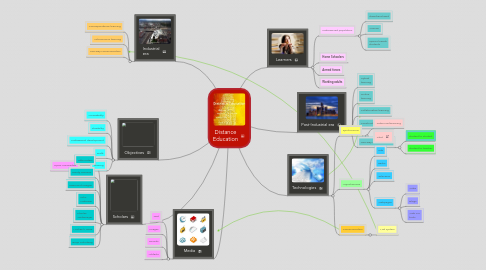Distance Education
por Debbie Brown


1. Industrial era
1.1. Correspondence learning
1.2. Autonomous learning
1.3. one-way communication
2. Media
2.1. Text
2.2. Images
2.3. Sounds
2.4. Artifacts
3. Objectives
3.1. Accessibility
3.2. Flexibility
3.3. Professional development
3.4. Profit
3.5. Sharing
3.5.1. Open Universities
4. Scholars
4.1. Otto Peters
4.2. Randy Garrison
4.3. Desmond Keegan
4.4. John Anderson
4.5. Charles Wedemeyer
4.6. Michael Moore
4.7. Borje Holmberg
5. Learners
5.1. underserved pupulation
5.1.1. disenfranchised
5.1.2. Women
5.1.3. Special needs students
5.2. Home Schoolers
5.3. Armed forces
5.4. Working adults
6. Post-Industrial era
6.1. Hybrid learning
6.2. Online learning
6.3. Collaborative learning
6.4. Constructivist principles
6.5. Two-way communication
6.5.1. student to student
6.5.2. student to teacher
7. Technologies
7.1. Synchronous
7.1.1. video-conferencing
7.1.2. Chat
7.2. Asynchronous
7.2.1. Cds
7.2.2. Radio
7.2.3. Television
7.2.4. Webpages
7.2.4.1. Wikis
7.2.4.2. Blogs
7.2.4.3. Web 2.0 tools
7.3. Communication
7.3.1. Mail system
